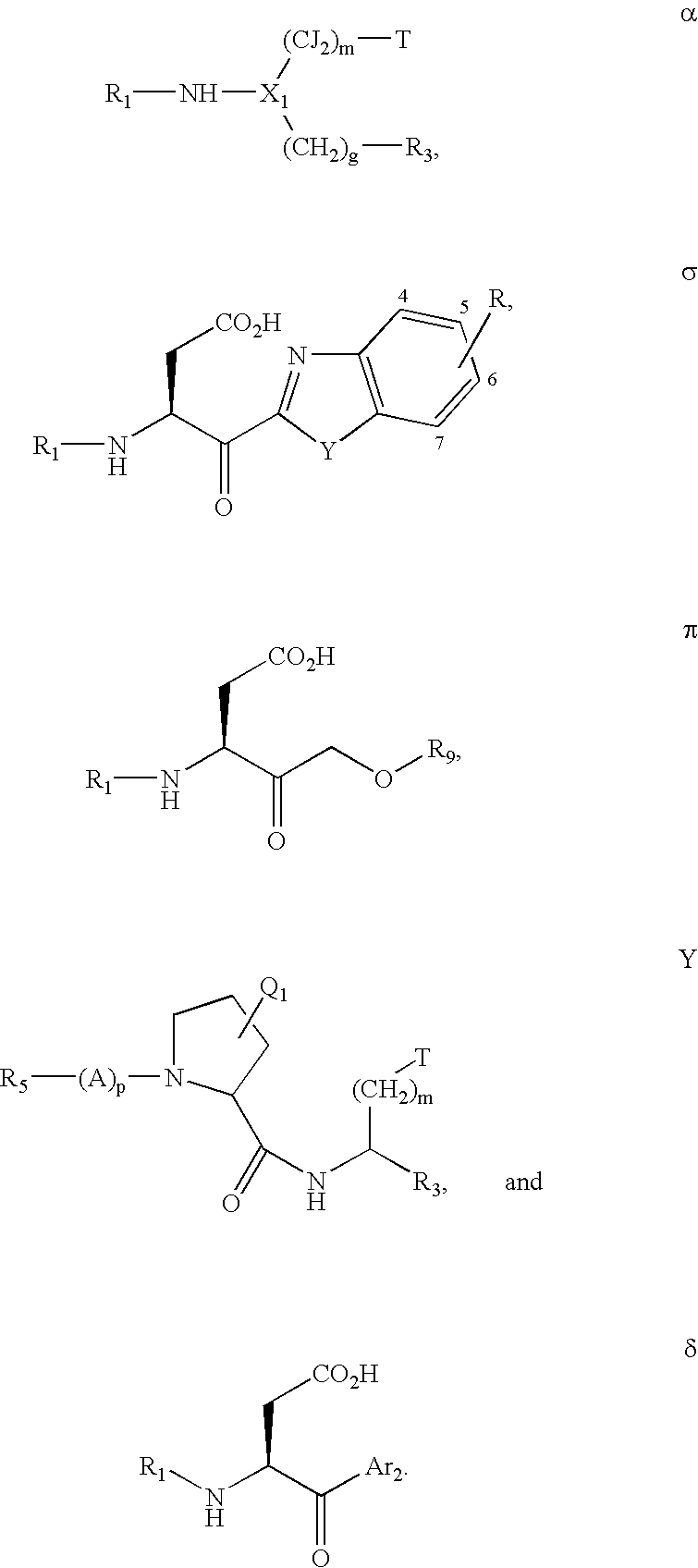Inhibitors of interleukin-1 beta converting enzyme
a technology of interleukin-1 beta and converting enzyme, which is applied in the field of inhibitors of interleukin-1 beta converting enzyme, can solve the problems of undesirable pharmacologic properties, inability to predict the primary structure of ice, and inability to predict the tertiary structure, etc., and achieve the effect of inhibiting the activity of that enzyme and treating or prophylaxis
- Summary
- Abstract
- Description
- Claims
- Application Information
AI Technical Summary
Benefits of technology
Problems solved by technology
Method used
Image
Examples
example 1
[0846] The following example demonstrates a process of drug design which embodies the present invention: [0847] Step 1) Pick 2 hydrogen bonding moieties of ICE, here, the backbone C═O and N—H of Arg-341. [0848] Step 2) Pick a scaffold, here, a pyridone derivative, and confirm that the hydrogen bonding moieties of the scaffold are capable of forming satisfactory hydrogen bonds with the hydrogen bonding moieties selected in step 1. This confirmation is performed by using molecular mechanics techniques to minimize the scaffold fragment in the context of the active site of ICE. [0849] Step 3) Pick a hydrophobic pocket, here, S2, as next target and a hydrophobic moiety, here, benzene. Minimize the benzene group within the S2 pocket to assure that substantial hydrophobic overlap is obtained. [0850] Step 4) Pick another hydrophobic pocket, here, S4, as the next target and a hydrophobic moiety, here, benzene. Minimize the benzene group within the S4 pocket to ensure that substantial hydro...
example 2
[0855] We obtained inhibition constants (Ki) and IC50 values for several compounds of this invention using the three methods described below:
1. Enzyme Assay with UV-Visible Substrate
[0856] This assay is run using an Succinyl-Tyr-Val-Ala-Asp-pNitroanilide substrate. Synthesis of analogous substrates is described by L. A. Reiter (Int. J. Peptide Protein Res. 43, 87-96 (1994)). The assay mixture contains:
65 μl buffer (10 mM Tris, 1 mM DTT, 0.1% CHAPS @pH 8.1)
10 μl ICE (50 nM final concentration to give a rate of −1 mOD / min)
[0857] 5 μl DMSO / Inhibitor mixture
[0858] 20 μl 400 μM Substrate (80 μM final concentration)
[0859] 100 μl total reaction volume
[0860] The visible ICE assay is run in a 96-well microtiter plate. Buffer, ICE and DMSO (if inhibitor is present) are added to the wells in the order listed. The components are left to incubate at room temperature for 15 minutes starting at the time that all components are present in all wells. The microtiter plate reader is set to ...
example 3
[0875] Compounds of Example 2 were synthesized as follows:
H. N—(N-Acetyl-tyrosinyl-valinyl-pipecolyl)-3-amino-4-oxobutanoic Acid
Step A. N—(N-tert-Butoxycarbonylpipecolyl)-4-amino-5-benzyloxy-2-oxotetrahydrofuran
[0876] Reaction of N-tert-butoxycarbonylpipecolic acid (460 mg, 2.0 mmol) and N-allyloxycarbonyl-4-amino-5-benzyloxy-2-oxotetrahydrofuran (530 mg, 1.82 mmol) was carried out by a method analogous to that reported by Chapman (Bioorg. & Med. Chem. Lett. 1992, 2, 613-618.) to give 654 mg of the title compound.
[0877]1H NMR (500 MHz, CDCl3 (existing as rotamers)) δ 7.35 (m, 5H), 6.88 (br. s, 1H), 4.9-4.45 (m, 4H), 3.95 (br. m, 2H), 3.06 (m, 1H), 2.9 (m, 1H), 2.7 (br. m, 1H), 2.45 (m, 1H), 2.2 (m, 1H), 1.7-1.5 (m, 3H), 1.45 (two s, 9H).
Step B. N-Pipecolyl-4-amino-5-benzyloxy-2-oxotetrahydrofuran
[0878] N—(N-tert-Butoxycarbonylpipecolyl)-4-amino-5-benzyloxy-2-oxo-tetrahydrofuran (654 mg) was dissolved in 15 ml of 25% trifluoroacetic acid in dichloromethane and stirred at room t...
PUM
| Property | Measurement | Unit |
|---|---|---|
| molecular weight | aaaaa | aaaaa |
| molecular weight | aaaaa | aaaaa |
| distance | aaaaa | aaaaa |
Abstract
Description
Claims
Application Information
 Login to View More
Login to View More - R&D
- Intellectual Property
- Life Sciences
- Materials
- Tech Scout
- Unparalleled Data Quality
- Higher Quality Content
- 60% Fewer Hallucinations
Browse by: Latest US Patents, China's latest patents, Technical Efficacy Thesaurus, Application Domain, Technology Topic, Popular Technical Reports.
© 2025 PatSnap. All rights reserved.Legal|Privacy policy|Modern Slavery Act Transparency Statement|Sitemap|About US| Contact US: help@patsnap.com



